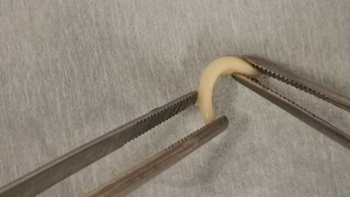
Once damaged, cartilage does not usually regrow and is difficult to replace living the patient “a bit disabled” after a disease or an injury. The specific case of skin cancer often affects the patient’s nose who can have cartilage samples taken from other parts of the body.
According to scientists, the nose is one of the most common places for skin cancer to form –, given how much sun it’s exposed to. Possible treatments often require doctors to remove sections of skin and cartilage but, given the nose’s prominence on the face, people will want those deformities patched up.
To address this issue, researchers at the University of Alberta have developed a new technique for 3D printing cartilage in custom shapes for use in surgical procedures.
The researchers used a specially designed hydrogel—a material similar to Jell-O—that could be mixed with cells harvested from a patient and then printed in a specific shape captured through 3D imaging. Over a matter of weeks, the material is cultured in a lab to become functional cartilage.
“It takes a lifetime to make cartilage in an individual, while this method takes about four weeks. So you still expect that there will be some degree of maturity that it has to go through, especially when implanted in the body. But functionally it’s able to do the things that cartilage does,” said Adetola Adesida, a professor of surgery in the Faculty of Medicine & Dentistry.
In general, the most conventional process requires doctors to use cartilage from another part of the body (e.g. ribs) but the process often leads to some complications, not to mention that the cartilage samples do not always blend well the patient’s nose.
Adesida, Boluk and graduate student Xiaoyi Lan led the project to create the 3D printed cartilage, probably using a CELLINK bioprinter, and in hopes of providing a better solution for a clinical problem facing many patients with skin cancer.
“It has to have certain mechanical properties and it has to have strength. This meets those requirements with a material that (at the outset) is 92 per cent water,” added Yaman Boluk, a professor in the Faculty of Engineering.
“When the surgeons restructure the nose, it is straight. But when it adapts to its new environment, it goes through a period of remodelling where it warps, almost like the curvature of the rib,” said Adesida. “Visually on the face, that’s a problem.
“The other issue is that you’re opening the rib compartment, which protects the lungs, just to restructure the nose. It’s a very vital anatomical location. The patient could have a collapsed lung and has a much higher risk of dying,” he added.
“This is to the benefit of the patient. They can go on the operating table, have a small biopsy taken from their nose in about 30 minutes, and from there we can build different shapes of cartilage specifically for them,” said Adesida. “We can even bank the cells and use them later to build everything needed for the surgery. This is what this technology allows you to do.”
The team is continuing its research and is now testing whether the lab-grown cartilage retains its properties after transplantation in animal models. The team hopes to move the work to a clinical trial within the next two to three years.


